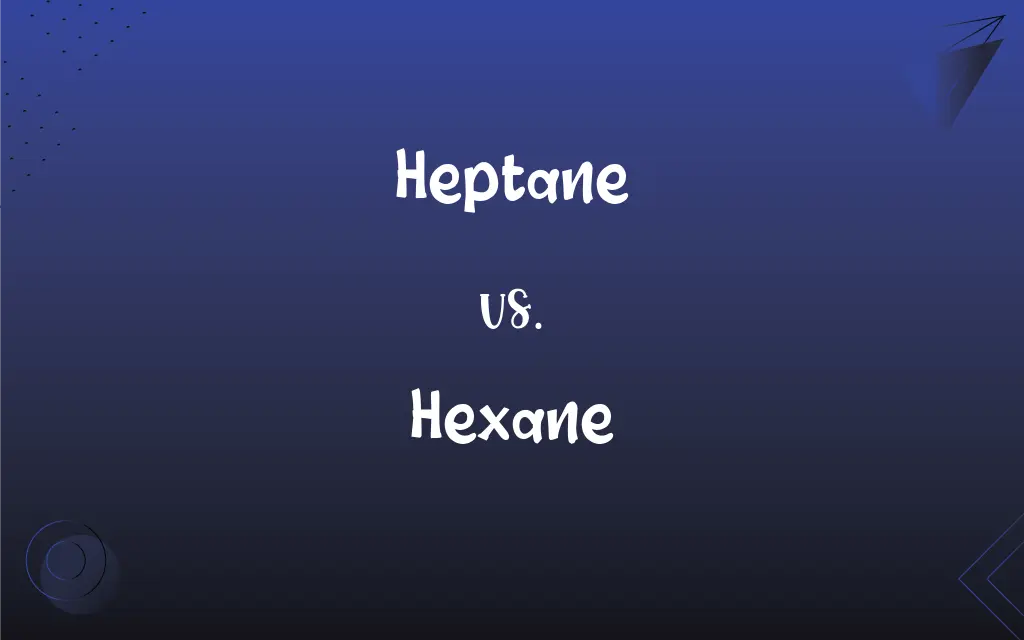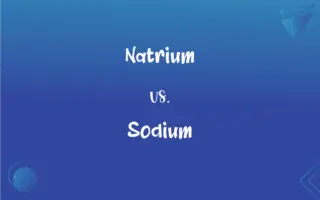Heptane vs. Hexane: What's the Difference?
Edited by Aimie Carlson || By Harlon Moss || Published on December 20, 2023
Heptane is a seven-carbon alkane with the formula C7H16, while hexane is a six-carbon alkane with the formula C6H14.

Key Differences
Heptane, a hydrocarbon with the molecular formula C7H16, consists of seven carbon atoms linked in a straight chain. Hexane, with the formula C6H14, contains six carbon atoms, making it a shorter molecule than heptane.
In terms of physical properties, heptane has a higher boiling point and is less volatile compared to hexane due to its longer carbon chain. Hexane, having a shorter chain, boils at a lower temperature and is more volatile.
Heptane is used in various applications, such as a solvent in laboratories and as a standard in octane rating tests for fuels. Hexane, on the other hand, is widely used as a solvent in the extraction of vegetable oils and in industrial cleaning processes.
The chemical behavior of heptane shows slightly higher reactivity in certain chemical reactions compared to hexane, due to its longer carbon chain. Hexane, being shorter, often reacts more quickly in certain types of reactions.
In terms of safety and environmental impact, both heptane and hexane are relatively similar, being flammable and having potential health risks upon inhalation. However, the specific hazards and handling precautions can vary slightly due to their different physical properties.
ADVERTISEMENT
Comparison Chart
Carbon Atoms
Seven
Six
Molecular Formula
C7H16
C6H14
Boiling Point
Higher boiling point
Lower boiling point
Volatility
Less volatile
More volatile
Common Uses
Solvent, octane rating standard
Solvent in oil extraction, cleaning
ADVERTISEMENT
Heptane and Hexane Definitions
Heptane
A seven-carbon alkane hydrocarbon.
Heptane is often used as a reference in fuel octane ratings.
Hexane
A six-carbon alkane hydrocarbon.
Hexane is extensively used in the extraction of edible oils from seeds.
Heptane
A hydrocarbon used in chemical synthesis.
Heptane was a key reactant in the organic synthesis process.
Hexane
A chemical compound with the formula C6H14.
Hexane is a common solvent in the industrial sector.
Heptane
A chemical compound with the formula C7H16.
Heptane is less volatile than its lower carbon counterparts.
Hexane
A volatile solvent used in various industrial processes.
Hexane's volatility makes it effective for quick drying applications.
Heptane
A solvent in various laboratory and industrial applications.
Heptane was used to clean the laboratory equipment.
Hexane
A constituent in gasoline.
Hexane contributes to the overall octane rating of gasoline.
Heptane
A component in gasoline and other fuels.
The presence of heptane improves the fuel's combustion quality.
Hexane
A hydrocarbon used in organic chemistry.
Hexane was used to dissolve reactants in an experiment.
Heptane
Any of several isomeric, volatile, colorless, highly flammable liquid hydrocarbons, C7H16, obtained in the fractional distillation of petroleum and used as solvents. The straight-chain isomer is also used as a standard in determining octane ratings and as an anesthetic.
Hexane
Any of several isomeric colorless flammable liquid hydrocarbons, C6H14, derived from the fractional distillation of petroleum and used as a solvent and as a working fluid in low-temperature thermometers.
Heptane
(organic compound) Any of the nine isomers of the saturated aliphatic hydrocarbon C7H16, obtained from petroleum, especially n-heptane (CH3(CH2)5CH3)
Hexane
(organic compound) Any of five isomeric aliphatic hydrocarbons, C6H14. They are colorless, volatile liquids.
Heptane
Any one of several isometric hydrocarbons, C7H16, of the paraffin series (nine are possible, four are known); - so called because the molecule has seven carbon atoms. Specifically, a colorless liquid, found as a constituent of petroleum, in the tar oil of cannel coal, etc.
Hexane
Any one of five hydrocarbons, C6H14, of the paraffin series. They are colorless, volatile liquids, and are so called because the molecule has six carbon atoms.
Heptane
A colorless volatile highly flammable liquid obtained from petroleum and used as an anesthetic or a solvent or in determining octane ratings
Hexane
A colorless flammable liquid alkane derived from petroleum and used as a solvent
FAQs
What is heptane?
A seven-carbon alkane with the formula C7H16.
How many carbon atoms does heptane have?
Seven carbon atoms.
How many carbon atoms are in hexane?
Six carbon atoms.
What is hexane's boiling point like?
Lower than heptane's, making it more volatile.
Where is hexane commonly used?
In solvent extraction of vegetable oils and cleaning.
What is the boiling point of heptane?
Higher than hexane, due to its longer carbon chain.
Are there safety concerns with heptane?
Yes, it's flammable and can be harmful if inhaled.
Can hexane be found in household items?
Occasionally, in products like adhesives and varnishes.
What is hexane?
A six-carbon alkane with the formula C6H14.
How does hexane react in chemical processes?
It can react more quickly in some reactions due to its shorter chain.
Does hexane have a role in gasoline?
Yes, as a component affecting the octane rating.
What are the environmental impacts of hexane?
Similar to heptane, including potential air pollution and health risks.
What are common uses of heptane?
As a solvent and in octane rating tests.
Can heptane dissolve substances?
Yes, it's used as a solvent.
What is heptane's role in fuel?
It's used as a standard in determining fuel octane ratings.
How is heptane handled in the lab?
With precautions due to its flammability and health hazards.
Is heptane found in consumer products?
Rarely, mostly in industrial or laboratory settings.
Is heptane more reactive than hexane?
Slightly, due to its longer carbon chain.
What are the safety precautions for hexane?
Similar to heptane, including flammability and inhalation risks.
Is hexane a good solvent?
Yes, especially for oils and greases.
About Author
Written by
Harlon MossHarlon is a seasoned quality moderator and accomplished content writer for Difference Wiki. An alumnus of the prestigious University of California, he earned his degree in Computer Science. Leveraging his academic background, Harlon brings a meticulous and informed perspective to his work, ensuring content accuracy and excellence.
Edited by
Aimie CarlsonAimie Carlson, holding a master's degree in English literature, is a fervent English language enthusiast. She lends her writing talents to Difference Wiki, a prominent website that specializes in comparisons, offering readers insightful analyses that both captivate and inform.






































































